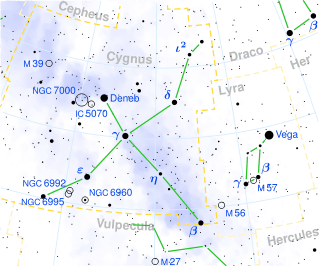W Cygni
 | |
| Observation data Epoch J2000.0 Equinox J2000.0 | |
|---|---|
| Constellation | Cygnus |
| Right ascension | 21h 36m 02.49619s[1] |
| Declination | +44° 22′ 28.5292″[1] |
| Apparent magnitude (V) | 5.10 - 6.83[2] |
| Characteristics | |
| Spectral type | M4e-M6e(Tc:)III[3] |
| U−B color index | +1.24[4] |
| B−V color index | +1.59[4] |
| Variable type | SRb[5] |
| Astrometry | |
| Radial velocity (Rv) | −12.87[6] km/s |
| Proper motion (μ) | RA: 65.17 ± 0.42[1] mas/yr Dec.: 1.74 ± 0.30[1] mas/yr |
| Parallax (π) | 5.72 ± 0.38[1] mas |
| Distance | 570 ± 40 ly (170 ± 10 pc) |
| Absolute magnitude (MV) | −0.43[7] |
| Details | |
| Mass | 0.98[8] M☉ |
| Radius | 227[8] R☉ |
| Luminosity | 5,888[8] L☉ |
| Temperature | 3,373[8] K |
| Other designations | |
| Database references | |
| SIMBAD | data |
W Cygni is a semi-regular variable star in the constellation Cygnus, located 570 light-years from Earth. It lies less than half a degree southeast of ρ Cygni.
Discovery

W Cygni is, at times, a naked-eye star but it was not given a Bayer or Flamsteed designation. It was discovered to be variable by John Ellard Gore, and first published in 1885.[9]
Variability
W Cygni has a maximum magnitude of 5.10 and a minimum magnitude 6.83. It is catalogued as having a primary period of 131.7 days, but shows variations with a variety of periods around 131 days as well as 234 days.[10][9] It is believed to be pulsating in the first overtone.[8]
Properties
W Cygni is a red giant on the asymptotic giant branch (AGB). Its spectral type ranges between M4e and M6e, and it shows possible elevated levels of Technetium.[2] The masses of AGB stars are poorly known, but using the pulsation properties of W Cygni, it mass is calculated to be slightly less than the sun's.[8]
Companion
W Cygni has been proposed as a binary star with a hotter main sequence companion, but it has not been confirmed.[11]
References
- 1 2 3 4 5 Van Leeuwen, F. (2007). "Validation of the new Hipparcos reduction". Astronomy and Astrophysics. 474 (2): 653. arXiv:0708.1752. Bibcode:2007A&A...474..653V. doi:10.1051/0004-6361:20078357. Vizier catalog entry
- 1 2 "W Cygni". AAVSO Website. American Association of Variable Star Observers. 10 July 2017. Retrieved 31 December 2013.
- 1 2 Ducati, J. R. (2002). "VizieR Online Data Catalog: Catalogue of Stellar Photometry in Johnson's 11-color system". CDS/ADC Collection of Electronic Catalogues. 2237: 0. Bibcode:2002yCat.2237....0D.
- ↑ Samus, N. N.; Durlevich, O. V.; et al. (2009). "VizieR Online Data Catalog: General Catalogue of Variable Stars (Samus+ 2007-2013)". VizieR On-line Data Catalog: B/gcvs. Originally published in: 2009yCat....102025S. 1. Bibcode:2009yCat....102025S.
- ↑ Famaey, B.; Pourbaix, D.; Frankowski, A.; Van Eck, S.; Mayor, M.; Udry, S.; Jorissen, A. (2009). "Spectroscopic binaries among Hipparcos M giants,. I. Data, orbits, and intrinsic variations". Astronomy and Astrophysics. 498 (2): 627. arXiv:0901.0934. Bibcode:2009A&A...498..627F. doi:10.1051/0004-6361/200810698.
- ↑ Cardini, D. (January 2005), "Mg II chromospheric radiative loss rates in cool active and quiet stars", Astronomy and Astrophysics, 430: 303–311, arXiv:astro-ph/0409683, Bibcode:2005A&A...430..303C, doi:10.1051/0004-6361:20041440.
- 1 2 3 4 5 6 Takeuti, Mine; Nakagawa, Akiharu; Kurayama, Tomoharu; Honma, Mareki (2013). "A Method to Estimate the Masses of Asymptotic Giant Branch Variable Stars". Publications of the Astronomical Society of Japan. 65 (3): 60. Bibcode:2013PASJ...65...60T. doi:10.1093/pasj/65.3.60.
- 1 2 Shears, Jeremy (2012). "John Ellard Gore: Of immensity and minuteness". 1203: arXiv:1203.6467. arXiv:1203.6467. Bibcode:2012arXiv1203.6467S.
- ↑ Glass, I. S.; Van Leeuwen, F. (2007). "Semiregular variables in the solar neighbourhood". Monthly Notices of the Royal Astronomical Society. 378 (4): 1543. arXiv:0704.3150. Bibcode:2007MNRAS.378.1543G. doi:10.1111/j.1365-2966.2007.11903.x.
- ↑ Ortiz, Roberto; Guerrero, Martín A. (2016). "Ultraviolet emission from main-sequence companions of AGB stars". Monthly Notices of the Royal Astronomical Society. 461 (3): 3036. arXiv:1606.09086. Bibcode:2016MNRAS.461.3036O. doi:10.1093/mnras/stw1547.